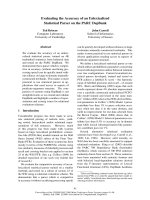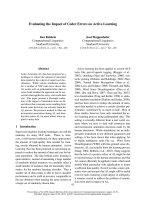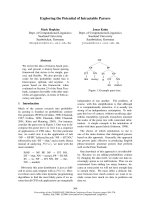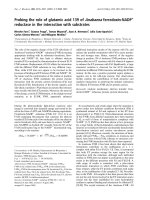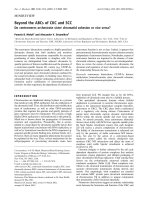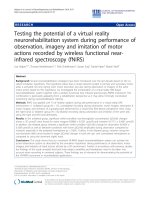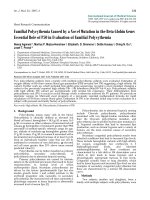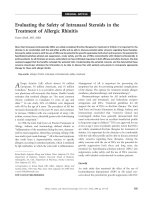Báo cáo y học: "Evaluating the potential of a novel oral lesion exudate collection method coupled with mass spectrometry-based proteomics for oral cancer biomarker discovery" docx
Bạn đang xem bản rút gọn của tài liệu. Xem và tải ngay bản đầy đủ của tài liệu tại đây (535.43 KB, 11 trang )
Kooren et al. Clinical Proteomics 2011, 8:13
/>
RESEARCH
CLINICAL
PROTEOMICS
Open Access
Evaluating the potential of a novel oral lesion
exudate collection method coupled with mass
spectrometry-based proteomics for oral cancer
biomarker discovery
Joel A Kooren1, Nelson L Rhodus2, Chuanning Tang1, Pratik D Jagtap3, Bryan J Horrigan1 and Timothy J Griffin1*
* Correspondence: tgriffin@umn.
edu
1
Department of Biochemistry,
Molecular Biology, and Biophysics,
University of Minnesota, 321
Church St SE, 6-155 Jackson Hall,
Minneapolis, Minnesota, 55455,
USA
Full list of author information is
available at the end of the article
Abstract
Introduction: Early diagnosis of Oral Squamous Cell Carcinoma (OSCC) increases the
survival rate of oral cancer. For early diagnosis, molecular biomarkers contained in
samples collected non-invasively and directly from at-risk oral premalignant lesions
(OPMLs) would be ideal.
Methods: In this pilot study we evaluated the potential of a novel method using
commercial PerioPaper absorbent strips for non-invasive collection of oral lesion
exudate material coupled with mass spectrometry-based proteomics for oral cancer
biomarker discovery.
Results: Our evaluation focused on three core issues. First, using an “on-strip”
processing method, we found that protein can be isolated from exudate samples in
amounts compatible with large-scale mass spectrometry-based proteomic analysis.
Second, we found that the OPML exudate proteome was distinct from that of whole
saliva, while being similar to the OPML epithelial cell proteome, demonstrating the
fidelity of our exudate collection method. Third, in a proof-of-principle study, we
identified numerous, inflammation-associated proteins showing an expected increase
in abundance in OPML exudates compared to healthy oral tissue exudates. These
results demonstrate the feasibility of identifying differentially abundant proteins from
exudate samples, which is essential for biomarker discovery studies.
Conclusions: Collectively, our findings demonstrate that our exudate collection
method coupled with mass spectrometry-based proteomics has great potential for
transforming OSCC biomarker discovery and clinical diagnostics assay development.
Keywords: Oral Pre-Malignant Lesion (OPML), Oral Squamous Cell Carcinoma (OSCC),
exudate, mass spectrometry-based proteomics, biomarker
Background
Oral cancer occurs most commonly (~90%) in the form of oral squamous cell carcinoma
(OSCC) and develops in stages starting with healthy oral epithelium progressing to an
Oral Pre-Malignant Lesion (OPML) and on to OSCC. The survival rate of OSCC has
remained static over the last 30 years at about 50%. However, where malignancy is
detected soon after the transition from OPML, treatments are more effective and survival is as high as 80% [1]. Despite the clinical need to distinguish between OSCC and
© 2011 Kooren et al; licensee BioMed Central Ltd. This is an Open Access article distributed under the terms of the Creative Commons
Attribution License ( which permits unrestricted use, distribution, and reproduction in
any medium, provided the original work is properly cited.
Kooren et al. Clinical Proteomics 2011, 8:13
/>
OPML, lesion types are not readily classified by simple visible inspection and more invasive tests are used instead. Currently the gold standard for classifying lesions is to use an
incisional biopsy coupled with histological analysis [2,3]. Yet biopsies have numerous
limitations: being invasive clinicians are hesitant to perform them, and patients are hesitant to agree to them due to the pain and discomfort of the procedure; the following histology requires expert analysis and is therefore expensive; and issues such as undersampling can lead to misdiagnosis [4].
An ideal alternative to scalpel biopsy would be a non-invasively collected sample rich
in molecular biomarkers which distinguish OPML and OSCC, and potentially predict
the transition from pre-malignancy to malignancy. One such alternative is the use of
protein or nucleic acid biomarkers in saliva that are secreted or shed from the oral
lesions [5,6]. However, despite its benefits, whole saliva is not the direct source of
potential biomarkers, and the complexity of the fluid [7] makes identification of potential biomarkers challenging. In contrast to whole saliva, some have directly analyzed
incisional biopsy tissues [8,9], but for clinical diagnostics this approach suffers from
the same limitations described above for scalpel biopsy.
Given the ongoing need for improved oral cancer detection, we describe here a promising alternative method for the direct and non-invasive sampling of oral lesions, which can
be coupled with mass spectrometry (MS)-based proteomics. Our method uses commercially available PerioPaper Strips, traditionally used for oral fluid sampling relevant to periodontal disease [10,11], to directly collect oral lesion exudate. Exudate is defined as the
fluid and cellular material present on the surface of inflamed tissue [12]. Our results show
that the exudate samples contain ample protein for large-scale proteomics analysis, and
that the exudate proteome of OPMLs is distinct from whole saliva, while being highly
similar to the proteome of lesion-associated epithelial cells. We also undertook a pilot
study comparing healthy tissue and OPML exudates, demonstrating that the method is
amenable to quantitative proteomic analysis necessary for biomarker discovery studies.
Collectively our results demonstrate the great potential of our exudate collection method
for oral cancer biomarker discovery and clinical diagnostics.
Methods
Patient information
Exudates and brush biopsies were collected from three patients diagnosed with a dysplastic OPML, at the University of Minnesota Dental School. For each OPML patient,
exudate samples were first collected from the oral lesion, followed by collection of the
brush biopsy from the same lesion. Exudates and brush biopsies from buccal mucosa,
and whole saliva were also collected from three healthy volunteers. The healthy volunteers had no major risk factors for OSCC (non-smokers, moderate to low alcohol use)
and were free of oral lesions. All samples were collected with written consent using an
IRB protocol approved by the University of Minnesota. Three different lesion and
three healthy samples were analyzed to provide some statistical significance for measurements of differential protein abundance between tissue types while balancing the
time and cost of large-scale proteomic analysis of individual patient samples.
Exudate sample collection and protein processing
To collect the exudate we first used rolled cotton to swab away ambient saliva around
tissue to be sampled (e.g. OPML). The rolled cotton was then moved adjacent to the
Page 2 of 11
Kooren et al. Clinical Proteomics 2011, 8:13
/>
area to be sampled to block flow of additional saliva onto the tissue. A PerioPaper strip
(Oraflow, Smithtown, New York) was left in position for ~30 seconds. Immediately
after collection the strip was placed in a microcentrifuge tube, on ice, and then transferred to a -20°freezer within minutes. The PerioPaper strips were subjected to on-strip
trypsin digestion in which each PerioPaper strip containing exudate was submerged in
100 μl buffer containing 5 mM DTT, 100 mM Tris pH 8.0 and boiled for 5 min. After
cooling to room temperature, 2 μg of sequencing grade trypsin (Promega, Madison,
WI) was added and the microcentrifuge tube was placed in 37°C water bath to digest
for 12 hours. The protein digest was then purified and concentrated using Waters SepPak 3cc cartridges as described [6] drying the purified peptides by vacuum centrifuge
(~2 hrs or until dry). The peptides were analyzed either directly by mass spectrometry
or subjected to strong cation exchange (SCX) HPLC fractionation as described below.
Brush Biopsy sample collection and protein processing
To collect brush biopsies we first dried the tissue to be sampled as with exudate collection. Next, we collected transepithelial cells from the tissue using an OralCDx brush
test kit (OralCDx laboratories, Inc. Suffern, NY) and following manufacturer’s suggested procedure. After collection of cells, the brush head was cut off from the handle
and submerged in 250 μL of 2× SDS cell lysis buffer (4% SDS, 20% glycerol, 10%
2-mercaptoethanol, and 100 mM Tris-HCl pH 6.8) and 1× protease inhibitors (Complete Mini, Roche Applied Science, Indianapolis, IN, USA) in a 2 mL microcentrifuge
tube. In order to extract proteins from the cell lysate while removing detergents and
minimizing other impurities, the proteins were precipitated with acetone added at a
5:1 ratio and left overnight at -20°C. Precipitated protein was centrifuged at 6000 rpm
for 10 min at 4°C, then rinsed and re-centrifuged with pure acetone twice. Proteins
were redissolved in trypsin digestion buffer, quantified using the BCA protein assay
(Pierce, Rockford, IL, USA), and digested with trypsin as described above for the exudate samples.
Collection and processing of control whole saliva samples
To collect the PerioPaper saliva samples we placed the PerioPaper strip at a location in
a healthy volunteer’s oral cavity where ambient saliva had pooled (the back of the
lower lip). The strip was allowed to saturate with saliva (< 20 sec) before being
removed. Once collected the PerioPaper saliva samples were immediately placed on
ice. On-strip digestion, as described above, was implemented within several minutes of
sample collection.
SCX HPLC fractionation
Peptide digests from exudates, brush biopsies, and the whole saliva samples were subjected to offline SCX HPLC fractionation essentially as in previous studies [7]. A UV
chromatogram (215 nm and 280 nm absorbance) was generated for every different
sample. For all samples (exudates or whole saliva), SCX fractions containing UV signals
indicating the presence of peptides were combined into 9 fractions for subsequent analysis by mass spectrometry. Loading amounts from each peptide fraction were normalized between different samples based on UV absorbance units, to ensure loading of
relatively equal amounts of peptides across all different samples being compared.
Page 3 of 11
Kooren et al. Clinical Proteomics 2011, 8:13
/>
Shotgun proteomics analysis: Tandem mass spectrometric analysis and sequence
database searching
The overall workflow used for data analysis is shown in Additional File 1, Figure S1.
Peptide mixtures from all sample types (exudates, brush biopsy and whole saliva) were
analyzed using online capillary liquid chromatography coupled with tandem mass spectrometry (MS/MS) using an LTQ-Orbitrap XL mass spectrometer (Thermo Scientific,
San Jose, CA). The chromatography conditions and instrumental parameters used have
been described [7]. The .RAW files generated by the LTQ-Orbitrap XL were converted
to .MSM file format peaklists using “Quant” module from MaxQuant’s (v 1.0.13.13,
Max-Planck Institute for Mass Spectrometry, Martinsried, Germany [13,14]. The .
MSM files are peaklists with high precursor mass accuracy and limited product ion
‘noise’ peaks. MaxQuant achieves high precursor mass accuracy by using information
from LC-MS precursor peaks. Top 6 MS/MS peaks per 100 Da are selected to generate
peaklists with limited background noise peaks. The .MSM peaklists were searched
using Mascot (v2.1, Matrix Sciences, London, United Kingdom) Daemon and with
following parameters: Orbitrap/FT as the instrument, no SILAC labeling, Methionine
oxidation as the only variable modification, Carbidomethyl as the fixed modification,
Trypsin as the enzyme, two missed cleavages, MS tolerance at 7 ppm and MS/MS tolerance at 0.5 Da and searched against target-decoy version of Human IPI database
(v3.52, Nov 2008) plus contaminant proteins (148372 forward plus reversed sequences).
Mascot search generates an output in .dat format that contains peptide-spectrum
matching information.
Mascot output .dat files were subjected to statistical validation and protein inference
using Scaffold Q+ v 3.0 (Proteome Software, Portland, OR). For peptide identification
the false discovery rate threshold was maintained at 1%. For quantification using spectral counts, total spectra identified in a dataset were normalized with spectra identified
in dataset that was to be compared. This normalization, which is achieved by using a
display option called “Quantitative value” in Scaffold v 3.0, is used to determine relative
abundance of proteins within datasets.
Normalized Spectral Counting and statistical analysis of quantitative proteomics data
Relative abundance levels of identified proteins in healthy and OPML exudates were
determined via normalized spectral counting [15], using the quantitative analysis feature in the Scaffold data viewer software (Version 3, Portland, OR). Quantitative values
for each protein were compared in the healthy individuals to those in the OPML individuals differences were determined via assigned P-values using the two-tailed students
t-test (type 2). All proteins with a P-value of less than 0.05 from the healthy exudate
to OPML comparison are included in Additional File 2, Table S1. When screening for
inflammation-associated proteins showing differential abundance (Table 1), a P-value
threshold of < 0.1 was used.
Results and discussion
Our objective was to determine whether exudate collection from oral lesions coupled
with MS-based shotgun proteomics is a viable option for oral cancer biomarker
discovery.
Page 4 of 11
Kooren et al. Clinical Proteomics 2011, 8:13
/>
Page 5 of 11
Table 1 Selected proteins showing increased relative abundance in OPML tissue
compared to healthy
P value1
Evidence of association with OPML and/or epithelial inflammation
hnRNPM 8.00
0.091
RNA binding, splicing and inflammation signaling; increased abundance
of hnRNPs has been measured in OPML tissue 17
IL1F6
22.00
0.016
Cytokine involved in inflammation and immune response; increases in
abundance in inflamed epithelial tissues 24; 25
LCN2
4.00
0.021
Iron transporter involved in immune response and apoptosis; activated
in inflammatory and pre-malignant tissues 26; 27
S100A8
2.02
0.088
Calcium binder and pro-inflammatory factor; increases in abundance in
OPML tissue 18
NQO1
10.00
0.050
Quinone reductase; induced under inflammatory conditions
Protein
Quantitative
ratio1
XRCC5/6 4.00/8.00
28
0.016/0.001 Protein complex involved in DNA repair; DNA damage response
proteins known to be activated in OPML 19 and other dysplastic
epithelial lesions 29
1
Quantitative values and P values determined as described in Experimental Methods.
To achieve our objective three fundamental questions needed to be answered: 1) Are
non-invasively collected tissue exudates compatible with MS-based shotgun proteomics? 2) What is the composition and extent of contamination by saliva of the exudate
proteome? 3) Can the differential abundance of protein within exudates collected from
different tissue (e.g. healthy tissue vs. OPML) be measured?
To answer the first question, we initially explored methods for isolating intact proteins from the PerioPaper strip. For these experiments, we used representative exudate
samples collected from healthy oral tissue using the PerioPaper strip as described in
Experimental Methods and shown in Figure 1. We first attempted to recover intact
proteins from the strips using SDS containing buffers. However, the amount of protein
recovered from the strips was very small, at or below the limit of detection for protein
quantification using the BCA assay or even reliable detection via SDS-PAGE (data not
shown). Given our inability to isolate ample amounts of intact protein, we instead
tested an alternate “on-strip” digestion method. We reasoned that direct trypsin digestion of proteins adhered to the PerioPaper strip, without relying on a first step of protein release, may maximize recovery of peptides. Furthermore, a direct “on-strip”
digestion would minimize sample handling steps and the use of SDS for protein solubilization, which must be removed prior to MS/MS and can lead to further sample
Figure 1 “On-Strip” digestion method. In order to produce a peptide solution for MS-based proteomics
analysis, we first dried oral epithelium to remove ambient saliva, then placed a PerioPaper strip on the
location of interest (Oral Pre-Malignant lesion or normal oral epithelium) and allowed it to absorb exudate.
The PerioPaper was next placed in trypsin solution for digestion of proteins to peptides for subsequent
processing and mass spectrometry analysis. See Experimental Methods for details.
Kooren et al. Clinical Proteomics 2011, 8:13
/>
losses. Given these collective advantages, we pursued a simpler and more direct
on-strip digestion method. Here, we submerged and boiled the PerioPaper strip in a
detergent-free, reducing buffer, added trypsin, and collected liberated peptides after
overnight incubation. Initially, we analyzed a 5% aliquot of peptides by MS/MS to evaluate whether adequate amounts of peptides were captured via the on-strip digestion
procedure to enable large-scale protein identification. We identified approximately 140
proteins on average from these samples, which compares favorably to the number of
identifications generated under identical mass spectrometry analysis and sequence
database searching conditions when analyzing complex peptide mixtures of known
quantities and loading ≤ 1 ug of total peptides. Therefore we concluded that the
remaining 95% of each sample was equivalent to 10-20 μg of protein for the purposes
of shotgun MS/MS analysis.
We next employed offline SCX HPLC peptide fractionation [16] in order to increase
the number of proteins identified. Using a representative exudate sample, UV absorbance readings at 215 nm and 280 nm were taken during the SCX fractionation. The
magnitude of the UV absorbance levels were similar to those measured when fractionating other complex samples of known quantities in the range of 12-15 ug, consistent
with our initial estimates above of total peptide amounts based upon the MS/MS
results from the 5% aliquots. Fractionation greatly increased our number of protein
identifications and sequence coverage for their identifications, producing ~700 identified proteins (< 1% estimated peptide False Discovery Rate).
We then moved on to answering our second question: What is the composition of the
OPML proteome and extent of contamination by whole saliva? One initial concern was
that the exudate strip would simply absorb saliva, despite our attempts to remove excess
ambient salivary fluid from the tissue prior to exudate collection. The high abundant
salivary proteins would potentially obscure the identification of lesion-associated proteins. To explore this issue, we compared the protein composition of exudates collected
from three different OPML patients, to the composition of whole saliva collected from
three different individuals. For this comparison, each whole saliva sample was collected
and processed in a similar manner to the exudates, by absorbing saliva onto a PerioPaper
strip, followed by on-strip digestion, SCX HPLC fractionation and LC-MS/MS analysis.
We first compared all proteins identified from three saliva samples to all proteins
identified from the OPML exudates (Figure 2a). These results showed that the vast
majority of proteins from whole saliva were also identified in the exudate samples, indicating that proteins from whole saliva are still prominent within the exudate samples.
Next we focused on some of the highest abundance proteins in whole saliva (salivary
amylase, lysozyme, proline-rich proteins, and cystatin proteins). We sought to determine
whether the relative amounts of these highly abundant proteins were different between
whole saliva and exudates. For this investigation, we used normalized spectral counting
as a means to assess the relative abundance of selected high abundance saliva proteins
within each sample. As shown in Figure 2b, all of the selected salivary proteins were present in significantly higher relative amounts in the whole saliva samples compared to
exudate samples.
To further elucidate the composition of the exudate proteome, we compared it to the
proteome derived from the epithelial cells collected from the OPMLs. Here, we collected OPML cells via brush biopsy (see Experimental Methods) from the same three
Page 6 of 11
Kooren et al. Clinical Proteomics 2011, 8:13
/>
Figure 2 Exudate proteome is distinct from whole saliva:2a Venn diagram showing overlap of total
protein identifications from PerioPaper collected whole saliva from three individuals compared to OPML
exudate proteins from three individuals. 2b Figure showing the relative proportion of major salivary
proteins in OPML exudates compared to brush biopsies. 2a and 2b. See Experimental Methods for dataset
generation details.
patients that we collected exudates, and analyzed the isolated protein using shotgun
proteomics. The proteins identified from the three brush biopsy samples were then
compared to the proteins identified from the three exudate samples (Figure 3). The
results show that these two sample types are highly similar, with 96% of the proteins
found in the exudate samples also present in the brushed cells.
Finally, we sought to answer the question of whether we could measure differential
abundance of proteins within exudates collected from different tissue types. Here we
decided to compare two distinct tissue types: healthy oral tissue and OPML tissue.
Our objective in these experiments was to provide proof-of-principle for conducting
Page 7 of 11
Kooren et al. Clinical Proteomics 2011, 8:13
/>
Figure 3 Exudate proteome is similar to cellular proteome of pre-malignant lesions. See
Experimental Methods for dataset generation details.
quantitative proteomic studies in exudate samples, rather than discover new biomarker
candidates. Therefore we focused on expected protein abundance differences within
the samples compared that could serve as a benchmark to determine whether we
could reliably measure differential protein abundance in exudate samples. Based on
prior studies of OPML and similar inflammatory epithelial lesions [17-19], there are
numerous proteins which we would expect to show increased abundance within these
inflammatory lesions compared to healthy tissues. We analyzed tissue exudates from
three different healthy individuals, and three different individuals with OPML. We
focused on the numerous proteins showing increased relative abundance in the OPML
samples determined via normalized spectral counting and statistical analysis (see
Experimental Methods section). Additional File 2, Table S1 shows all proteins determined to show differential abundance between the two groups. Table 1 shows selected
proteins with increased relative abundance in the OPML tissue compared to the
healthy tissues. As detailed in Table 1, prior studies have established the increased
abundance of all of these proteins either in OPMLs or related inflammatory epithelial
tissues. Figure 4 graphically shows the measured abundance levels of the proteins in
Table 1 as determined via spectral counting.
In this study, we first addressed the fundamental question of whether exudates collected via PerioPaper strips can be analyzed using MS-based proteomics, as new sample types such as these may not contain ample protein amounts to facilitate their
analysis using MS. Although isolating intact proteins from the strips proved difficult,
our on-strip digestion method liberated ample amounts of peptides for large-scale
shotgun proteomic analysis.
We next investigated the composition of the OPML exudate proteome. One concern
was absorbance of ambient saliva, and the high abundance proteins contained therein
which may obscure the identification of lower abundance exudate proteins. However,
comparison of exudate samples to whole saliva samples revealed that high abundance
salivary proteins were greatly decreased in their relative amounts within the exudate
samples. Thus, our exudate collection procedure sufficiently removes ambient saliva,
which should enable identification of proteins sampled directly from the lesion tissue.
Page 8 of 11
Kooren et al. Clinical Proteomics 2011, 8:13
/>
Figure 4 Plot of abundance levels of inflammation-associated proteins identified in healthy and
OPML tissue exudates. See Table 1 for more details on each protein.
Interestingly, the exudate proteome was highly similar to the proteome of epithelial
cells collected directly from the lesions via brush biopsy. This indicated that the PerioPaper strip also absorbs cells from the surface of the lesion, whose protein contents
can be detected using our processing method. The presence of cellular proteins is in
keeping with the accepted definition of an exudate, which is a mixture of fluid, cells
and cellular debris on the surface of inflamed tissue [12]. Thus, exudate collection with
PerioPaper strips may offer an alternative to brush biopsy collection, with the advantage that the processing of the samples via on-strip trypsin digestion being simpler
than processing intact cells collected via brush biopsy, which includes additional steps
of cell lysis and protein precipitation. Additionally, a paper-strip based collection
method also has potential use in micro- or nano-scale devices for point-of-care clinical
testing [20].
Finally we investigated the feasibility of quantitative proteomic analysis of exudate
samples collected from different tissue types. By comparing exudates from healthy oral
tissue to OPML tissue we expected to identify inflammation-related proteins at
increased abundance in the lesion exudates. Indeed this was the case, demonstrated by
the proteins listed in Table 1. Thus we conclude that our method of exudate sampling
and MS-based proteomic analysis for profiling is compatible with profiling differential
protein abundance, necessary for biomarker discovery studies.
Conclusions
We demonstrate here a promising new method for the non-invasive, direct sampling of
oral lesions, compatible with MS-based proteomics. In future studies, we envision
application of this method to comparative analysis of OPMLs and malignant oral
lesions. This should provide a powerful means to identify protein biomarkers distinguishing these lesion types that may be useful for early detection of malignant transformation. Given our findings, lesion exudates should be amenable to the full suite of
proteomic analysis tools, including those aimed at identifying post-translational modifications or sequence variants [21] that may serve as powerful biomarkers of oral cancer.
Additionally, exudate samples analyzed by MS-based proteomics should be amenable
Page 9 of 11
Kooren et al. Clinical Proteomics 2011, 8:13
/>
to a metaproteomics approach [22] seeking to identify bacterial or viral components of
oral lesions which may play a role in pathogenesis. Proteins identified within the
exudate samples may also serve as a guide to identifying lesion-derived proteins shed
into the saliva that could be used for oral cancer detection in this easily collected fluid
[6,23]. Finally, the PerioPaper strips could provide the foundation for point-of-care
clinical devices for oral cancer diagnostics, given the emergence of such devices
designed for paper-based fluid sampling and analysis [20].
Additional material
Additional file 1: Workflow for MS-based proteomic analysis.
Additional file 2: Proteins with significant differential abundance in healthy tissue versus OPML.
Acknowledgements and funding
This work was supported in part by NIH grant R01DE017734 and through an NIH Training Grant Fellowship
T32GM008347 to J.A.K. We also thank the Center for Mass Spectrometry and Proteomics at the University of
Minnesota for instrumental resources and the Minnesota Supercomputing Institute for computational support.
Author details
Department of Biochemistry, Molecular Biology, and Biophysics, University of Minnesota, 321 Church St SE, 6-155
Jackson Hall, Minneapolis, Minnesota, 55455, USA. 2Oral Medicine, Diagnosis and Radiology, School of Dentistry,
University of Minnesota, 515 Delaware St SE, Minneapolis, Minnesota, 55455, USA. 3Minnesota Supercomputing
Institute, University of Minnesota, 117 Pleasant Street SE, Minneapolis, Minnesota, 55455, USA.
1
Authors’ contributions
JAK: Conceived experiments, carried out analysis of exudate samples, analyzed and interpreted data, wrote the
manuscript. NLR: Conceived experiments, collected samples. CT: carried out analysis of brush biopsy samples, analyzed
data. PDJ: Conceived data analysis workflow, analyzed and interpreted data.
BJH: carried out collection and analysis of saliva samples. TJG: Conceived experiments, analyzed and interpreted data,
wrote the manuscript. All authors read and approved the final manuscript.
Competing interests
The authors declare that they have no competing interests.
Received: 27 July 2011 Accepted: 13 September 2011 Published: 13 September 2011
References
1. SEER Cancer Statistics Review, 1975-2007. [ />2. Rhodus NL: Oral cancer: leukoplakia and squamous cell carcinoma. Dent Clin North Am 2005, 49(1):143-165, ix.
3. Lingen MW, Kalmar JR, Karrison T, Speight PM: Critical evaluation of diagnostic aids for the detection of oral cancer.
Oral Oncology 2008, 44(1):10-22.
4. Pentenero M, Carrozzo M, Pagano M, Galliano D, Broccoletti R, Scully C, Gandolfo S: Oral mucosal dysplastic lesions
and early squamous cell carcinomas: underdiagnosis from incisional biopsy. Oral Diseases 2003, 9(2):68-72.
5. Lee JM, Garon E, Wong DT: Salivary diagnostics. Orthodontics & Craniofacial Research 2009, 12(3):206-211.
6. De Jong EP, Xie HW, Onsongo G, Stone MD, Chen XB, Kooren JA, Refsland EW, Griffin RJ, Ondrey FG, Wu BL, et al:
Quantitative Proteomics Reveals Myosin and Actin as Promising Saliva Biomarkers for Distinguishing Pre-Malignant
and Malignant Oral Lesions. Plos One 2010, 5(6).
7. Bandhakavi S, Stone MD, Onsongo G, Van Riper SK, Griffin TJ: A Dynamic Range Compression and Three-Dimensional
Peptide Fractionation Analysis Platform Expands Proteome Coverage and the Diagnostic Potential of Whole Saliva.
Journal of Proteome Research 2009, 8(12):5590-5600.
8. Ralhan R, Desouza LV, Matta A, Tripathi SC, Ghanny S, Gupta SD, Bahadur S, Siu KWM: Discovery and verification of
head-and-neck cancer biomarkers by differential protein expression analysis using iTRAQ labeling,
multidimensional liquid chromatography, and tandem mass spectrometry. Molecular & Cellular Proteomics 2008,
7(6):1162-1173.
9. Ralhan R, DeSouza LV, Matta A, Tripathi SC, Ghanny S, Gupta SD, Bahadur S, Siu KWM: Discovery and verification of
head-and-neck pre-cancer and cancer biomarkers by differential protein expression analysis using iTRAQ-labeling
and multidimensional liquid chromatography and tandem mass spectrometry. Cancer Biomarkers 2008, 4(3):158-158.
10. Grant MM, Brock GR, Matthews JB, Chapple ILC: Crevicular fluid glutathione levels in periodontitis and the effect of
non-surgical therapy. Journal of Clinical Periodontology 2010, 37(1):17-23.
11. Johnson RB, Streckfus CF, Dai X, Tucci MA: Protein recovery from several paper types used to collect gingival
crevicular fluid. Journal of Periodontal Research 1999, 34(6):283-289.
12. Dorand’s medical dictionary: Saunders. 2007.
13. Cox J, Mann M: MaxQuant enables high peptide identification rates, individualized p.p.b.-range mass accuracies
and proteome-wide protein quantification. Nature Biotechnology 2008, 26(12):1367-1372.
Page 10 of 11
Kooren et al. Clinical Proteomics 2011, 8:13
/>
Page 11 of 11
14. Cox J, Matic I, Hilger M, Nagaraj N, Selbach M, Olsen JV, Mann M: A practical guide to the MaxQuant computational
platform for SILAC-based quantitative proteomics. Nature Protocols 2009, 4(5):698-705.
15. Lundgren DH, Hwang SI, Wu LF, Han DK: Role of spectral counting in quantitative proteomics. Expert Review of
Proteomics 2010, 7(1):39-53.
16. Gygi SP, Rist B, Griffin TJ, Eng J, Aebersold R: Proteome analysis of low-abundance proteins using multidimensional
chromatography and isotope-coded affinity tags. Journal of Proteome Research 2002, 1(1):47-54.
17. Ralhan R, DeSouza LV, Matta A, Tripathi SC, Ghanny S, DattaGupta S, Thakar A, Chauhan SS, Siu KWM: iTRAQMultidimensional Liquid Chromatography and Tandem Mass Spectrometry-Based Identification of Potential
Biomarkers of Oral Epithelial Dysplasia and Novel Networks between Inflammation and Premalignancy. Journal of
Proteome Research 2009, 8(1):300-309.
18. Driemel O, Murzik U, Escher N, Melle C, Bleul A, Dahse R, Reichert TE, Ernst G, von Eggeling F: Protein profiling of oral
brush biopsies: S100A8 and S100A9 can differentiate between normal, premalignant, and tumor cells. Proteomics
Clinical Applications 2007, 1(5):486-493.
19. He Y, Chen QM, Li BQ: ATM in oral carcinogenesis: association with clinicopathological features. Journal of Cancer
Research and Clinical Oncology 2008, 134(9):1013-1020.
20. Klasner SA, Price AK, Hoeman KW, Wilson RS, Bell KJ, Culbertson CT: Paper-based microfluidic devices for analysis of
clinically relevant analytes present in urine and saliva. Analytical and Bioanalytical Chemistry 2010, 397(5):1821-1829.
21. Menon R, Zhang Q, Zhang Y, Fermin D, Bardeesy N, DePinho RA, Lu C, Hanash SM, Omenn GS, States DJ: Identification
of Novel Alternative Splice Isoforms of Circulating Proteins in a Mouse Model of Human Pancreatic Cancer. Cancer
Research 2009, 69(1):300-309.
22. Rudney JD, Xie H, Rhodus NL, Ondrey FG, Griffin TJ: A metaproteomic analysis of the human salivary microbiota by
three-dimensional peptide fractionation and tandem mass spectrometry. Molecular Oral Microbiology 2010,
25(1):38-49.
23. Hu S, Arellano M, Boontheung P, Wang JH, Zhou H, Jiang J, Elashoff D, Wei R, Loo JA, Wong DT: Salivary Proteomics
for Oral Cancer Biomarker Discovery. Clinical Cancer Research 2008, 14(19):6246-6252.
doi:10.1186/1559-0275-8-13
Cite this article as: Kooren et al.: Evaluating the potential of a novel oral lesion exudate collection method
coupled with mass spectrometry-based proteomics for oral cancer biomarker discovery. Clinical Proteomics 2011
8:13.
Submit your next manuscript to BioMed Central
and take full advantage of:
• Convenient online submission
• Thorough peer review
• No space constraints or color figure charges
• Immediate publication on acceptance
• Inclusion in PubMed, CAS, Scopus and Google Scholar
• Research which is freely available for redistribution
Submit your manuscript at
www.biomedcentral.com/submit
